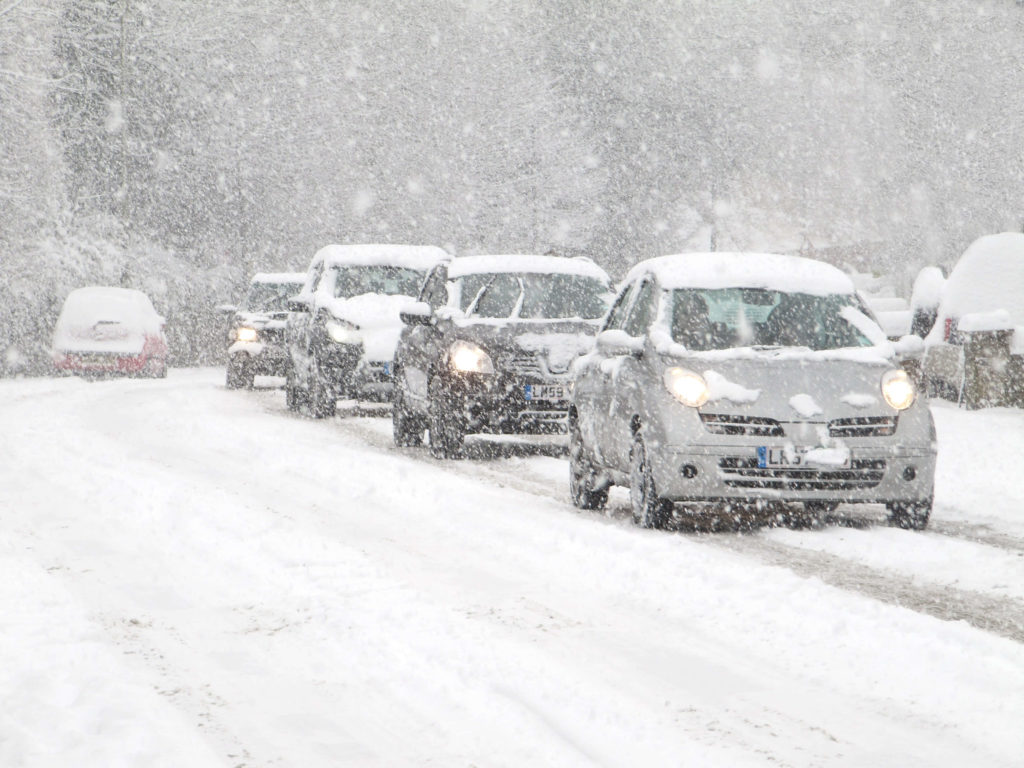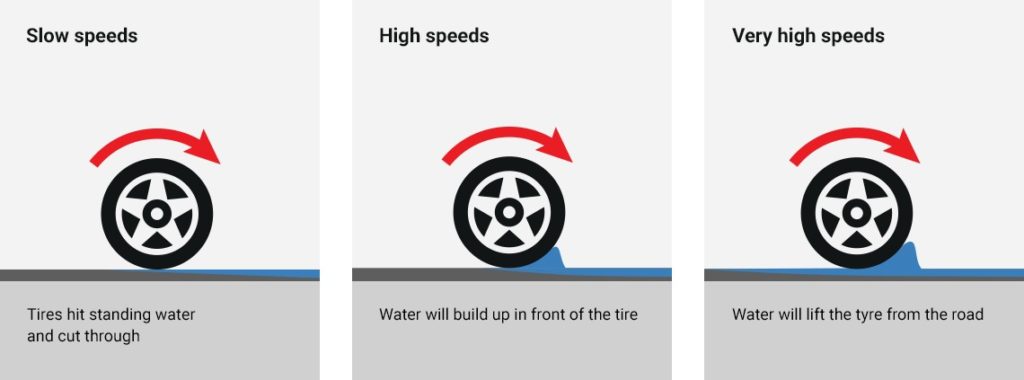Last Updated on July 3, 2024
Driving safely in all weather conditions is a crucial skill for any driver, especially learner drivers in the UK. Here in the UK, weather conditions can be unpredictable, no matter the time of year. From spring snow to summer rainstorms, you never know what you will encounter on the roads. Being prepared for any weather is essential for ensuring your safety and that of other road users.
Whether you’re dealing with icy roads in winter, fog in autumn, or heavy rain in summer, each type of weather brings its own unique challenges, particularly if you are new to driving. But don’t worry, we are here to help! In this comprehensive guide, we will cover important tips and precautions for driving in various weather conditions. This blog will help to equip you with the knowledge you need to drive safely, no matter the weather.
Contents
How to prepare for driving in different weather
Snow and Ice
Fog
Rain
Hailstone
Thunderstorms
Wind
Sun
Conclusion
How to prepare for driving in different weather
Before you get out on the road there are some key steps to help you prepare. You never want to be stuck without something you might need when you are trying to drive safely in different weather conditions.
- Check the forecast– make sure you check on your local weather before you set off. Checking weather can help you be prepared if you need to bring a coat or pack more essentials in your car to keep safe. Weather forecasts can also help to keep you informed if it will be icy so you can factor in de-icing your car.
- Pack for the worst – Keep an emergency kit in your car with essential items in case you break down or need to stop due to extreme weather. Include a blanket, shovel, phone charger, torches, map, warning triangle, water, and a first aid kit. This kit will help you stay safe if driving becomes too dangerous. For a complete list of recommended items, you can refer to the AA’s survival kit checklist.
- Leave more time – Weather and the roads in general can make planning hard to do. Make sure you leave enough time to get to your destination! This is especially important if you are aware of weather warnings or traffic news.
- Check your Tyres – Ensure your tyres are in good condition, as worn tyres won’t grip the road well in snow and rain. The legal tread depth limit is 1.6mm, but it’s advisable to maintain a depth of around 3mm for better safety. You can find detailed instructions on how to check your tyres here.
- Refill Screen wash – Make sure to top up on your screen wash and that the screen wash you choose to use does not freeze below -35 degrees.
Driving In Snow and Ice
Snow is often the weather that makes people the most anxious. We polled 2274 participants and 33% said snow made them the most anxious to drive in.
It is often not just the snow that causes fear and anxiety but the added slush and ice that makes driving difficult. Ice makes the roads very dangerous, and drivers need to pay a lot more attention in order to drive safely. You need to be very careful when driving in snowy winter conditions.

Tips for Driving in the Snow
- Ensure Visibility
Before setting off, clear all snow and ice from your windows, mirrors, and roof. This ensures you have maximum visibility and prevents snow from falling onto your windshield while driving, which could obstruct your view.
- Start in Second Gear
When driving in snow, try starting your car in second gear to reduce wheel slip when pulling away. This can help you maintain traction and avoid skidding. If your car has a winter mode, use it to aid in smooth starts.
- Stick to Main Roads
Main roads are more likely to be gritted and cleared of snow. Avoid side streets and rural routes that may be more hazardous. Plan your route to include well-travelled roads where conditions are likely better.
- Slow Down and Increase Following Distance
Reduce your speed significantly and increase the distance between you and the vehicle ahead. Stopping distances can be ten times longer on snowy and icy roads, so give yourself plenty of time to react.
- Handle Skids Correctly
If you start to skid, steer gently into the skid and avoid slamming on the brakes. For example, if your rear wheels slide left, steer left. This helps you regain control without causing further instability.
How to plan a safe journey in the snow and ice
If you must drive in snow you need to be very careful in order to drive safely. If the weather is too icy and you do not feel confident driving, you should find alternative transport especially if you are a learner or new driver. Keeping to main roads is best when conditions are snowy and icy. The roads are more likely to be gritted and clear from hazards when you are driving. Often less busy roads are less maintained during the winter, so they can be more dangerous.
Driving on main roads may also allow you to avoid steep hills and higher ground areas where conditions are worse. If you can’t avoid hills when driving, remember to leave plenty of room. When heading uphill try to remain in the same gear at a constant speed. When driving downhill, you should continue to leave plenty of space but remain in low gear.
How to stay in control when driving in snow and ice?
Keep your speed down! Going fast is more dangerous in snow and ice as it may take longer for you to brake. You should aim to go slower and leave plenty of stopping distance. As a rule of thumb aim to brake when you are around 10 cars away from the vehicle in front. So, make sure you are not going too fast and keep space between you and other vehicles on the road.
If you do start to skid, it’s important to keep hold of the steering wheel and not to brake excessively. Instead, lightly steer into it, for example, if the rear of your car is sliding to the left, start to slowly steer to the left. When you’re heading towards a bend, start to brake before you steer the steering wheel. If your car does lose grip, try not to panic, take your foot off the accelerator and make sure your wheels are pointing in the direction you want to go in.

What about black ice?
Black ice, is a thin layer of ice that forms on roads which is slippery and transparent, meaning it can be hard to see. Areas that are more prone to black ice are quiet roads, shaded stretches of road, tunnels, bridges and flyovers.
Be aware when you are driving and look for shiny spots on the road or areas other drivers are avoiding. This is a good indicator of black ice.
If you encounter black ice out on the roads do not hit the brakes, maintain your speed and keep the steering wheel straight. Avoid any sudden movements and use your gears to slow down if necessary.
Tips for Driving on Black Ice
- Identify Potential Black Ice Areas
Be cautious on bridges, overpasses, shaded areas, and tunnels where black ice is more likely to form. These areas freeze more quickly and can remain icy longer than other parts of the road.
- Stay Calm and Avoid Sudden Movements
If you encounter black ice, keep your steering wheel straight and avoid sudden movements. Do not hit the brakes suddenly; instead, gently lift your foot off the accelerator to slow down.
- Use Your Gears to Slow Down
Instead of braking, use lower gears to help control your speed. This can reduce the chance of skidding and help maintain traction on icy surfaces.
- Watch for Shiny Patches
Black ice often appears as a glossy or wet-looking patch on the road. Pay attention to how other vehicles behave; if they start to slide or swerve, it’s a good indicator that black ice may be present.
- Maintain a Safe Following Distance
Increase the distance between you and the car ahead to allow more time to react if they encounter black ice. This extra space can be crucial for avoiding collisions.
Driving In Fog
When driving in foggy weather, the biggest challenge you will face is your vision. Depending on how much fog there is you may only be able to see a short distance in front of you and it can obscure your vision of road markings, signs, other drivers and pedestrians.
You need to take extra care when driving in fog and be sure to assess your visibility before you set off as you don’t want to get stuck in very bad fog and risk a potential accident. Luckily your car has some features that can make driving in the fog a little easier.
What are fog lights?
Fog lights are extra lights located on the front and rear of cars. They are designed to make you easier to be seen in foggy conditions.
Fog lights are designed to cut through the fog, unlike standard headlights, fog lights illuminate the road underneath the fog to reduce the glare. Regular headlights are mounted higher on the front of the car and aren’t angled downwards; this can cause glare when foggy, which will be the time to use your fog lights. All cars have rear fog lights, but many also have front fog lights.
The Highway Code states that you must use fog lights if you cannot see more than 100m in front of you. You must turn your fog lights off when visibility improves to stop dazzling other drivers. If not, you could be faced with a fine of £30 for using your fog lights incorrectly. Make sure you are turning them on at the right time and turning them off too to keep everyone safe and avoid paying a fine.
Before setting off in the fog make sure your rear (and front) fog lights are working so you can stay safe. If they are not working, you should not drive in the fog and should wait for it to clear. Once cleared you should repair your fog lights.
Tips for Driving in the Fog
- Allow Extra Room to Brake
Fog significantly reduces visibility, making it harder to see vehicles and obstacles ahead. Increase your following distance to allow extra room for braking. This additional space helps prevent collisions if the car in front of you stops suddenly.
- Open Your Window to Listen to Traffic
When visibility is low, open your window slightly to listen for oncoming traffic and other road users. This can provide vital clues about your surroundings, helping you stay aware of vehicles, cyclists, and pedestrians you might not see.
- Remember to Check Your Mirrors Before Slowing Down
Before reducing your speed, always check your mirrors to ensure that the drivers behind you are aware of your intentions. Sudden deceleration in fog can lead to rear-end collisions if other drivers cannot react in time.
- Use Fog Lights Correctly
Use your fog lights when visibility is less than 100 meters. These lights are designed to cut through fog and make your vehicle more visible to others. Turn them off when visibility improves to avoid dazzling other drivers.
- Avoid Overtaking
Overtaking in foggy conditions can be dangerous due to limited visibility. Stay in your lane and avoid passing other vehicles unless absolutely necessary. If you must overtake, do so with extreme caution, ensuring you have a clear view of the road ahead.
Driving In Heavy Rain
According to the MET Office, 9 out of 10 weather related deaths and serious injuries on the roads took place in the rain. Rain can cause your tyres to skid more easily, heavy rain can reduce visibility and with flooding you can cause damage to your car.
If the rain is so heavy that you’re struggling to see, even with your wipers on, you should pull over somewhere safe until the rain calms down.
Can I drive in floods?
No, If you drive through water that is over a foot deep and stall, you could risk getting water into your engine. This can be expensive to fix and water damage can lead to your car being scrapped. If you do come up to flooding, slow down and drive in a low gear to avoid your car from stalling. It’s important to note if the rain is particularly bad, it might be worth waiting and drive when the worst has passed and to avoid flooded areas.
What’s Aquaplaning?
It only takes 12 inch deep water to completely lift you and your vehicle from the surface of the road. Aquaplaning tends to happen when you’re at a high speed, where water can build in front of the tyre and lift your tyre from the road surface. This makes your car unresponsive to steering as you have lost contact with the road. This is very dangerous and should be avoided.

Tips for Driving in the Rain
Don’t Overlook Wet Leaves
- Wet leaves may seem harmless, but they can be as slippery as ice, causing your car to skid unexpectedly. Always slow down when driving over patches of leaves, especially during autumn, and avoid sudden manoeuvres to maintain control.
Test Your Wipers
- Before setting off, ensure your windshield wipers are in good working condition. Functional wipers are crucial for maintaining visibility in heavy rain. Replace worn-out wiper blades regularly to prevent streaking and smearing on your windshield.
Drive on the Highest Section of the Road
- When possible, drive on the highest section of the road to avoid areas where water tends to accumulate. Standing water can cause hydroplaning, where your tyres lose contact with the road surface, making it difficult to control your vehicle.
Keep Both Hands on the Wheel
- In rainy conditions, maintaining a firm grip on the steering wheel with both hands is essential. This gives you better control over the vehicle and helps you respond quickly to unexpected situations, such as skidding or aquaplaning.
Reduce Your Speed and Increase Following Distance
- Rain reduces visibility and increases stopping distances, so it’s crucial to reduce your speed and increase the distance between you and the vehicle in front. This extra space gives you more time to react and brake safely in case of sudden stops or obstacles.
@collingwoodinsurance Driving in the rain can make driving a little more difficult! Here are out top tips to stay safe in the rain 🌧️ #drivinginrain #learntodrive #uk #rain #drivinglessons #drive #learnerdriver #passingtest ♬ I Think I Like When It Rains – WILLIS
Driving In Hailstone
Hail stone can cause some challenges when driving and can also cause damage to your car. If you are caught driving in hailstone that is very heavy, reduce your speed and aim to find somewhere safe and sheltered to pull over. Heavy hail can cause damage to your car especially at high speeds! It could break your windows, scratch or damage your car. So slow down and find shelter if you feel like the weather could damage your car.
Similarly, to other weather conditions make sure you have clear visibility when you are driving too. Use your windscreen wipers to help you see and if they are not clearing quickly enough find somewhere safe to stop until the weather clears up.
Tips For Driving In Hailstone
- Reduce Your Speed
Hail can create slippery road conditions and reduce visibility. Slow down to maintain control of your vehicle and avoid skidding.
- Find Shelter if Possible
If hail becomes severe, find a safe place to pull over, such as under a bridge or in a covered parking area. Hailstones can damage your car and obstruct your view, making it unsafe to continue driving.
- Use Your Wipers and Lights
Turn on your windshield wipers to improve visibility and use your headlights to make your vehicle more visible to others. Ensure your wipers are in good condition to handle the rapid buildup of hail.
- Keep a Safe Distance from Other Vehicles
Increase the distance between you and the car in front to account for longer stopping distances on slick, hail-covered roads. This extra space helps prevent rear-end collisions.
- Stay Alert for Larger Hailstones
Larger hailstones can cause significant damage to your car, including breaking windows. If the hail becomes too heavy, pull over safely and wait for it to subside before continuing your journey.
Driving In Thunderstorms
If you do find yourself stuck driving in a thunderstorm it is recommended that you put all the windows up and stay in the vehicle. Most cars will pass the current through the vehicle and into the ground and should not harm the passengers inside. This is advised by the MET office, They do acknowledge that some cars with fabric roofs, metal interior handles or GPS can have more problems in thunderstorms. If your car has any of these features, it may be best to find somewhere safe and get out of the car.
There is also added hazards when you are stuck in a vehicle during a thunderstorm. There can be fallen powerlines which would be very dangerous to you and your car. If you do have to stop and wait in your car, try to do so away from any potential hazards.
Tips for Driving in Thunderstorms
- Avoid Driving if Possible
If there are severe weather warnings for thunderstorms, it’s best to stay off the roads. Thunderstorms can cause flooding, fallen debris, and reduced visibility, making driving dangerous.
- Stay Inside Your Car
If you are caught in a thunderstorm, remain in your car with the windows closed. Your vehicle provides protection from lightning strikes. Avoid touching metal parts inside the car to stay safe.
- Watch for Fallen Power Lines
Thunderstorms can bring down power lines, which are extremely hazardous. Do not drive over downed lines and keep a safe distance from them. If a power line falls on your car, stay inside until help arrives.
- Slow Down and Use Headlights
Reduce your speed and turn on your headlights to improve visibility and ensure other drivers can see you. Heavy rain and dark clouds can significantly reduce visibility.
- Be Cautious of Flooding
Avoid driving through flooded areas, as water can damage your vehicle’s engine and electrical systems. Even shallow water can be dangerous, as it can hide debris and create strong currents.
Driving In The Wind
If you are driving in severely windy weather, the best way to avoid accidents is to postpone your journey. Extreme wind can be unpredictable with flying debris, falling trees and trouble with handling your car. Wind can cause more cars on the road to swerve to avoid obstacles that can increase accidents. When stormy winds reach 60mph, it can be extremely dangerous and it’s best to avoid driving completely.
If you do have to travel in the wind, make sure you check for the safest route by the following advice from local news sources. If you can, avoid routes that are particularly prone to intense wind and obstacles.
When it comes to overtaking, be extra careful, especially past high sided vehicles (these are vehicles over 2.9m), this is due to the gust from the side as you clear past. In general, you should allow more room between you and other road users, especially when you’re near cyclists, motorcyclists, lorries, trailers and buses as they are particularly susceptible to being moved by high winds.
Tips for Driving Safely in Wind
- Make Sure You Park Your Car in a Safe Place
Park your car in a sheltered area to protect it from strong winds and flying debris. Avoid parking near trees, poles, or other structures that could fall or be blown over.
- Try to Avoid Debris Left on the Road
High winds can blow debris onto the road, creating hazards. Be vigilant and avoid driving over or near debris that could damage your tyres or cause you to lose control.
- Keep Your Speed Down (Safely & Legally)
Reducing your speed helps maintain control of your vehicle in windy conditions. Slower speeds make it easier to react to sudden gusts and prevent swerving or losing control.
- Keep Both hands on the Wheel
Hold the steering wheel firmly with both hands to maintain better control of your vehicle. Sudden gusts of wind can push your car off course, and a firm grip helps you correct your direction quickly.
- Be Cautious When Passing High-Sided Vehicles
High-sided vehicles like lorries and buses are more affected by strong winds and can create turbulence as you pass them. Give these vehicles extra space and be prepared for sudden gusts as you overtake.
Driving In The Sun
The sun may not seem as though it would be dangerous to drive in, however there are some risks that you should be aware of.
The sun can become a problem during not only hot summer days, but on rainy and snowy days too! Sun can reflect off surfaces and can make it hard for you to see clearly. This can happen on the bright white snow or in puddles. If the sun is reflecting into your eyes and causing you problems, it is always good to keep a pair of sunglasses in your car.
Another problem with driving in sunny weather is overheating. Being inside the car on a hot day can cause the vehicle to become very hot. This can be very distracting and uncomfortable to drive in. Make sure you are opening your windows and using your aircon to help with the heat. Also pack a cold bottle of water to keep you hydrated!

If it is a hot day try to avoid parking in the sun and opt for shaded or enclosed areas. This can help with overheating as your seats will not absorb as much heat.
Tips for Driving in the Sun
- Use Your Car’s Sun Visor
Lower your car’s sun visor to block direct sunlight from your eyes. Adjust it as needed to maintain a clear view of the road ahead. This can be particularly helpful during sunrise and sunset when the sun is low on the horizon.
- Keep Your Dashboard Free of Reflective Items
Remove any items from your dashboard that could reflect sunlight into your eyes. This includes shiny objects like phones, CDs, or metallic decorations, which can increase glare and reduce visibility.
- Keep Your Windshield Clean
A dirty windshield can amplify the effects of sun glare. Regularly clean both the inside and outside of your windshield to ensure maximum visibility.
- Choose Routes with Shade
If possible, plan your route to include roads with ample tree cover or buildings that provide shade. This can reduce the amount of direct sunlight you encounter, making for a more comfortable and safer drive.
- Stay Hydrated and Cool
Driving in hot weather can be uncomfortable and distracting. Use your car’s air conditioning to stay cool and keep a bottle of water handy to stay hydrated. Avoid parking in direct sunlight to keep your car’s interior temperature manageable.
Conclusion
There are a lot of extra considerations that you should make if you are driving in any weather conditions. The type of weather you are driving in can have and overall effect on how your car handles and your safety when driving. Always be well prepared to tackle the weather and take precautions to postpone a drive if necessary!
When you are learning to drive you want to get in as much practice as possible. Practicing driving in different weather conditions when safe to do so, helps you be prepared for when you pass your test.
Collingwood Learner Driver insurance has no curfews so you can practice at a time that suits you!
Get a Learner Insurance Quote with Collingwood
FAQs
- How can I improve my visibility when driving in heavy rain?
Ensure your wipers are in good condition, use your headlights, and reduce your speed to enhance visibility and reaction time.
- What should I do if my car starts to skid on ice?
Keep a firm grip on the steering wheel, avoid slamming the brakes, and gently steer in the direction of the skid to regain control.
- How can I prepare my car for driving in extreme cold?
Check your tyre tread depth, ensure your battery is in good condition, top up antifreeze, and carry an emergency kit with essentials like a blanket, shovel, and de-icer.
- Is it safe to drive through standing water or floods?
Avoid driving through standing water. If you must, drive slowly and steadily in low gear to prevent stalling and avoid water entering the engine.
- What are the best practices for driving in foggy conditions?
Use fog lights if visibility is severely reduced, reduce your speed, and keep a safe distance from the vehicle in front. Avoid using high beams as they can reflect off the fog and impair your visibility further.









